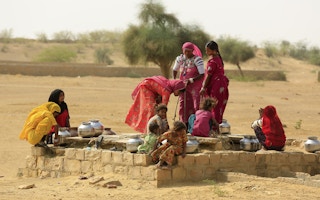As global politics move forward on top of tectonic shifts in geopolitics, economies, technologies and societies, one truth remains: unchecked climate change is the trigger that will challenge our chances of a secure, prosperous and indeed peaceful human development.
I will first set out the big picture around this challenge and then delve into the immediate substantive tasks that we must tackle this year and over the coming years and decades.
Since I started as head of the UNFCCC secretariat last year, I have been very clear on what I believe to be the big truth of our time, that the ultimate objectives of the Paris Climate Change Agreement and the Sustainable Development Goals (SDGs) will be achieved only if they are fully recognised as one encompassing agenda.
The straightforward yet also complex job of my secretariat, therefore, is to ensure that all actors in this agenda – government, business and citizenry – understand why this is the reality, what the overwhelming benefits of action are and how they can best respond individually and in partnership with the UNFCCC secretariat and the UN as a whole.
Firstly, the UNFCCC is itself not a standalone entity but part of this bigger picture in which a unified development agenda is becoming the core agenda for governments under the United Nations and thus the prime focus for UN agencies and other multilateral institutions. No single process or agency can possibly adopt, or try to adopt, all aspects of the solution under its wing.
Leadership responsibility for different aspects of progress will be coordinated by those organisations best placed in resources and skills to effect change. Credit for progress must flow to the entire organisation rather than to its individual parts.
I am often asked whether one new problem or another in the world could negatively impact this agenda. Of course, different events could be negative but, I think, only temporarily. The danger now is not so much that the world does not understand the threat. Paris and the SDGs are proof that it does.
The danger is that the narrative, this link between a stable climate and secure, peaceful human development, is not yet understood clearly enough for people across government, business and society to recognise how all the different strands of policy, incentives and strategies can and should come together in this single agenda.
The leadership of women is key to climate action
A good example is women. Ensuring their leadership opportunities in political, economic and public life is a particularly effective catalyst for climate action. Meanwhile, SDG Goal #5 recognises gender equality as a foundation of sustainable development. Such symbiotic relationships run through the whole climate and development agenda.
The secretariat’s very own Momentum for Change programme is full of encouraging and inspiring initiatives that show what can be done when successful climate action and development are seen as delivering a combined set of benefits.
A good example is the Solar Sister project – a Momentum for Change Lighthouse Activity – which supports women to run small-scale clean energy businesses, providing them with an income that is not seasonally dependent. Solar Sister’s network of over 2,200 entrepreneurs run micro-enterprises in some of the most remote communities in sub-Saharan Africa that lack access to the grid and whose needs have not been met by current market forces.
Three big tasks for 2017-2018
The UNFCCC secretariat’s core task remains full and effective support of the inter-governmental climate change process. After Paris, that task also critically includes supporting governments to implement the agreement.
Three closely interlinked objectives stand out as pressing areas: completing the international “Rulebook” of the Paris Agreement; helping governments implement and strengthen their national climate action plans (NDCs) and continuing to support the rapid scaling up of climate finance.
By the end of 2018, governments are looking to complete a clear, consistent and comprehensive set of operating rules and guidance under which countries account transparently for their emissions reductions, adaptation action, flows of climate finance and technology development and transfer.
The ambition of the Paris Agreement, the essential pathway to limit global temperature rises to 2 degrees Celsius and as close to 1.5 as possible, is anchored in the almost universal set of NDCs based on the special circumstances and undertakings of each country.
But if that is all there was – a set of diverse and undifferentiated promises to act – it would be impossible to assess or even understand whether the world was on track to meet the Agreement’s goals.
Hence the fundamental need for the rulebook, providing a transparency of action and progress to build trust amongst governments that each country is delivering on the pledges made in their NDCs.
The rulebook has three central objectives: accounting for climate action, taking stock of global progress and compliance with the nature and form of national reporting. I expect governments to move further forward on this at the next meeting, in Bonn, in May.
At the same time, I want the secretariat to increase our outreach efforts not only to governments but to non-government stakeholders who implement action. Their action is key both to fulfil the commitments made so far and to demonstrate that NDCs can be more ambitious and can put us on the path to achieve the goals of the Agreement.
“
The danger is that the narrative, this link between a stable climate and secure, peaceful human development, is not yet understood clearly enough for people across government, business and society to recognise how all the different strands of policy, incentives and strategies can and should come together in this single agenda.
Raising ambition
We can do this in two ways. First, our communications must be rigorous and consistent in explaining but also providing in more detail the links in the climate and sustainability narrative. Second, raising implementation ambition is now a core objective of the inter-governmental process under the Agreement.
One of the foundation components of the Agreement is the creation of an ambition mechanism to take stock and increase the ambition of NDCs.
In 2018, the first stock-taking exercise – the Facilitative Dialogue – represents a major opportunity for countries to increase the ambition of their current NDCs ahead of 2020. The final formal design of this dialogue is another key objective for the negotiations.
Finance for climate action is where governments and the private sector probably come closest together and I see three criteria for higher success, especially in developing countries where huge, new openings for climate investment exist.
First, the positive connections between climate action benefits, quality investment returns and policy incentives need to be reinforced again and again. Global climate finance flows may well reach one trillion dollars a year soon but this remains a small part of the global total.
Second, reducing risk is critical and is the point at which public finance, most often in cooperation with UN and multilateral organisations, is a most important component to leverage private finance.
Third – and an area which I think is not as closely analysed and developed yet as I would like – we must not forget that the implementation of the rulebook and the increasing clarity and ambition of the NDCs as detailed blueprints of national climate action can themselves become new benchmarks for investment grade instruments.
For example, the firm Moody’s has already posited that NDCs could become part of a country’s ratings assessment, while an NDC’s substantive goals could become one of the platforms for raising new capital for the country and its associated investors.
None of these are small tasks but together they compose a clear line of immediate work to achieve the ultimate goal of unified action on climate and sustainable development.
Patricia Espinosa is executive secretary of the United Nations Framework Convention on Climate Change. This post is republished from NDCI Global.


















